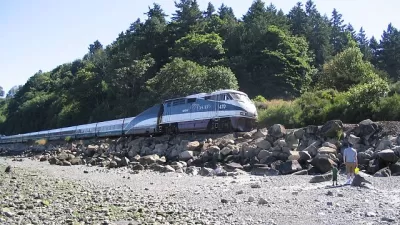The crash in Cayce, South Carolina on Sunday killed the engineer and conductor riding in the Amtrak locomotive, injuring over 100 passengers and crew members. A locked switch had directed Amtrak #91 into a siding where it hit a parked CSX train.
Amtrak Train 91, carrying about 139 passengers and eight crew members, left Boston shortly after 6 AM on Saturday, Feb. 3, headed for Miami. Soon after departing the Columbia, South Carolina station early Sunday morning (see schedule [pdf] for Silver Service / Palmetto route), the train left the one-track mainline and entered the siding where it hit the parked CSX freight train at around 2:35 a.m. ET, Feb. 4, near Cayce (pronounced CAY-cee).
"National Transportation Safety Board (NTSB) chairman Robert Sumwalt said Sunday that human error played a role in the train wreck," reports Sammy Fretwell for The State on Feb. 5.
CSX, as owner of the track, was responsible for making sure the track switch was in the right position. But Sumwalt said it was locked in the wrong position, which sent the Amtrak train off course.
He told reporters the accident “was indeed a tragic human error.’’
CSX says it does not dispute the facts in the case so far.
"The Lexington County coroner, Margaret Fisher, identified the dead as Amtrak employees: the train’s 54-year-old engineer, Michael Kempf, of Savannah, Ga., and a conductor, Michael Cella, 36, of Orange Park, Fla.," report Alan Blinder, Christina Caron and John Jeter for The New York Times. The freight train was reported to have been unoccupied at the time.
“The key to this investigation is learning why that switch was lined that way because the expectation was, of course, that the Amtrak train would be operating like this,” [Sumwalt] said, pointing to a whiteboard showing the passenger train’s southbound direction.
Federal Railroad Administration statistics have shown that in recent years the agency has had an average of about two derailments a month, accounting for about one-quarter of the accidents it reports.
As is the custom after passenger train crashes and derailments, talk turns to positive train control (PTC), a wireless technology utilizing GPS which may have been present on the locomotive and the track, but wasn't operational.
"Even though it is early in the investigation, Sumwalt was adamant about the benefits of positive train control, and how it could have factored into an incident like Sunday’s," reported Lori Aratani and Faiz Siddiqui for The Washington Post on Feb. 4.
“An operational PTC system is designed to prevent this type of accident,” he said. “A fully operational positive train control system could have avoided this accident, and that’s what it was designed to do."
The derailment comes less than a week after a chartered Amtrak train carrying GOP congress members to their West Virginia retreat on Jan. 31 slammed into a trash truck at a rural grade crossing near Crozet, Virginia, killing one occupant of the truck and injuring two others. On Dec. 18, Amtrak train 501 left the new Tacoma, Wash. station on its maiden voyage on the new, bypass route to Portland when it derailed over Interstate 5 near DuPont, Wash., killing three passengers, injuring over 100.
FULL STORY: Fatal train crash puts spotlight on CSX railroad crew

Alabama: Trump Terminates Settlements for Black Communities Harmed By Raw Sewage
Trump deemed the landmark civil rights agreement “illegal DEI and environmental justice policy.”

Study: Maui’s Plan to Convert Vacation Rentals to Long-Term Housing Could Cause Nearly $1 Billion Economic Loss
The plan would reduce visitor accommodation by 25% resulting in 1,900 jobs lost.

Why Should We Subsidize Public Transportation?
Many public transit agencies face financial stress due to rising costs, declining fare revenue, and declining subsidies. Transit advocates must provide a strong business case for increasing public transit funding.

Paris Bike Boom Leads to Steep Drop in Air Pollution
The French city’s air quality has improved dramatically in the past 20 years, coinciding with a growth in cycling.

Why Housing Costs More to Build in California Than in Texas
Hard costs like labor and materials combined with ‘soft’ costs such as permitting make building in the San Francisco Bay Area almost three times as costly as in Texas cities.

San Diego County Sees a Rise in Urban Coyotes
San Diego County experiences a rise in urban coyotes, as sightings become prevalent throughout its urban neighbourhoods and surrounding areas.
Urban Design for Planners 1: Software Tools
This six-course series explores essential urban design concepts using open source software and equips planners with the tools they need to participate fully in the urban design process.
Planning for Universal Design
Learn the tools for implementing Universal Design in planning regulations.
Smith Gee Studio
Alamo Area Metropolitan Planning Organization
City of Santa Clarita
Institute for Housing and Urban Development Studies (IHS)
City of Grandview
Harvard GSD Executive Education
Toledo-Lucas County Plan Commissions
Salt Lake City
NYU Wagner Graduate School of Public Service



























